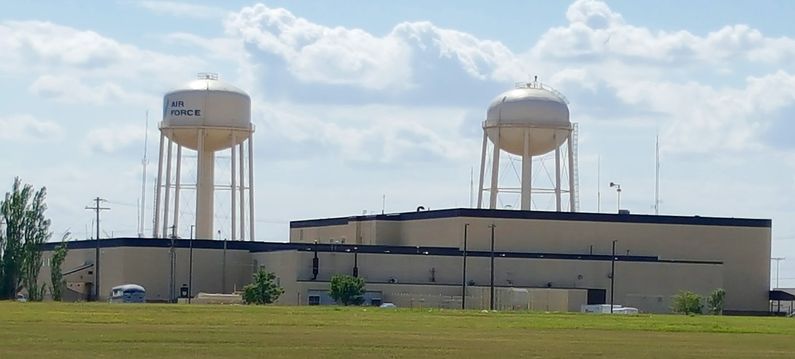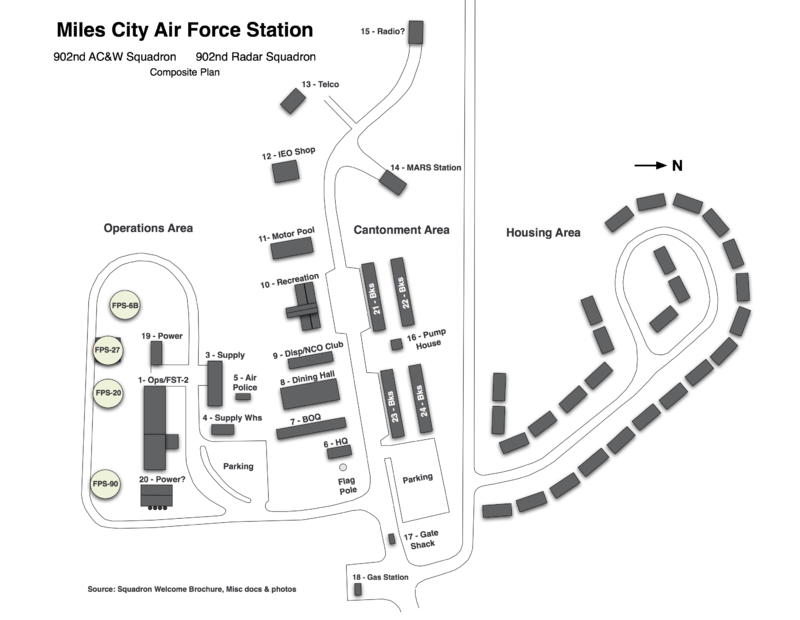Miles City Air Force Station
|
Miles City Air Force Station (1954-1968) - A Cold War Air Force Radar Station first established in 1954 near Miles City, Custer County, Montana. Named Miles City Air Force Station after the location. The station was built on a portion of the old Fort Keogh military reservation. Initially assigned a Permanent ID of M-98 and later a Sage ID of Z-98. Abandoned in 1968. HistoryEstablished on 1 Oct 1954 and became operational in 1955 as Miles City Air Force Station manned by the 902nd AC&W Squadron. The station initially had both a Ground-Control Intercept (GCI) and an early warning mission. The early warning mission involved tracking and identifying all aircraft entering their airspace while the GCI mission involved guiding Air Force interceptors to any identified enemy aircraft. Controllers at the station vectored fighter aircraft at the correct course and speed to intercept enemy aircraft using voice commands via ground-to-air radio. Initial equipment included the mobile MPS-7 search radar and an MPS-14 height-finder radar. The MPS-7 search radar was replaced by an FPS-20 in 1958 and that radar was upgraded to an FPS-66 in 1961 and later to an FPS-27. The MPS-14 height-finder was replaced by an FPS-6 in 1961. SAGE System TransitionThe transition of the manual GCI system to the automated SAGE system began with the installation of the FST-2 coordinate data transmitter and search radar upgrades. The FST-2 equipment digitized the radar returns and transmitted the digital returns to the SAGE direction center. Under the SAGE System, interceptor aircraft were directed to their targets by the direction center computers and controllers, greatly reducing the need for local controllers and equipment at every radar station. The FST-2 was a very large digital system using vacuum tube technology. Over 6900 vacuum tubes were used in each FST-2 requiring 21 air-conditioned cabinets, 40 tons of air conditioning, 43.5 kva of prime power, and usually a large new addition to the operations building. The FST-2B modification added two more cabinets but with newer solid-state (transistor) technology to process coded responses from aircraft transponders. SAGE System Operation
The site began operation as a SAGE site on 1 Jan 1961 initially feeding the Minot SAGE Direction Center DC-19 at Minot AFB. With the closure of DC-19 in 1963, Miles City was connected to the Malmstrom SAGE Direction Center DC-20 at Malmstrom AFB and remained connected to them until the site closed in 1968. Gap FillersMiles City AFS was responsible for maintaining two remote unattended gap-filler radar sites. The gap-filler sites were placed in locations where the main search radar lacked coverage. The unattended gap filler sites were placed in locations where the main search radar lacked coverage. These sites were equipped with short range FPS-14 or FPS-18 search radars and FST-1 Coordinate Data transmitters that sent digitized radar target data to a SAGE direction center and to the main radar site. Both the radar set and the FST-1 were dual channel to increase site up time. Maintenance teams were dispatched for regularly scheduled maintenance or when fault indicators on the FSW-1 remote monitoring equipment suggested the site had problems. The FSW-1 also allowed remote operation of specific functions such as channel changes for the radar and for the FST-1, it also allowed remote operation of the diesel generators at the gap filler site. Miles City AFS was responsible for the gap-filler sites at Glendive and Brockway Montana.
ClosureThe initial closure announcement for Miles City came in November 1964 and cited a closure date by 1 Jul 1967. That date was extended to the end of FY 1969 in January 1967. When the final closure announcement came on 15 Feb 1968 the base had 108 military personnel assigned and 11 civilians employed. Miles City AFS and the 902nd were deactivated on 18 Jun 1968. Physical PlantThe physical plant of the site was divided into the main site Operations area, a cantonment area, a housing area, and a separate radio site. The main site operations area housed the operations building, the radar towers, tech supply buildings, and the backup generators. The cantonment area housed the four enlisted barracks, bachelor officer's quarters, orderly room, dining hall, motor pool, recreation hall, NCO Club, and other support structures. Apart from the main site was a 27-unit housing area for married personnel. Seven units were designated for officers and twenty units for NCOs. The 27 housing units were built in 1958 and included one four-bedroom unit for the commander, six, three-bedroom officers' quarters, and twenty, three-bedroom units for NCOs. Just outside the front gate was a gas station operated by the NCO club. A separate GATR radio site housed the radio equipment for directing aircraft intercepts. Like most early radar stations, Miles City originally had a radio transmitter site and a separate radio receiver site used by local controllers for voice direction of fighter interceptors to their targets. With the SAGE System, the SAGE Direction centers had the primary task of directing intercepts and the local radio sites were reconfigured, usually into a single site that was known as the Ground to Air Transmitter Receiver (GATR) site. The GATR site communicated with the interceptors from either the local site or the SAGE direction center via voice commands and/or a digital data link. 
* Not the actual building numbers but reference numbers to the plan.
Current StatusPart of the Fort Keogh Livestock and Range Research Lab (USDA), Montana State University. Some buildings remain. A Highway marker is located on I 94 at the eastbound Hathaway rest stop (zoom out on the map to see the marker location). All of the housing area homes are gone. Part of the Ops building and parts of the FPS-27 tower remain. All the other radar towers are gone. Nearly all the cantonment buildings have been reduced to just the foundations with a few partial walls still upright. The Telco building seems to be still standing. Access to the site is blocked by a locked gate along the roadway.
See Also:
Sources:
Fortification ID:
Visited: No
|